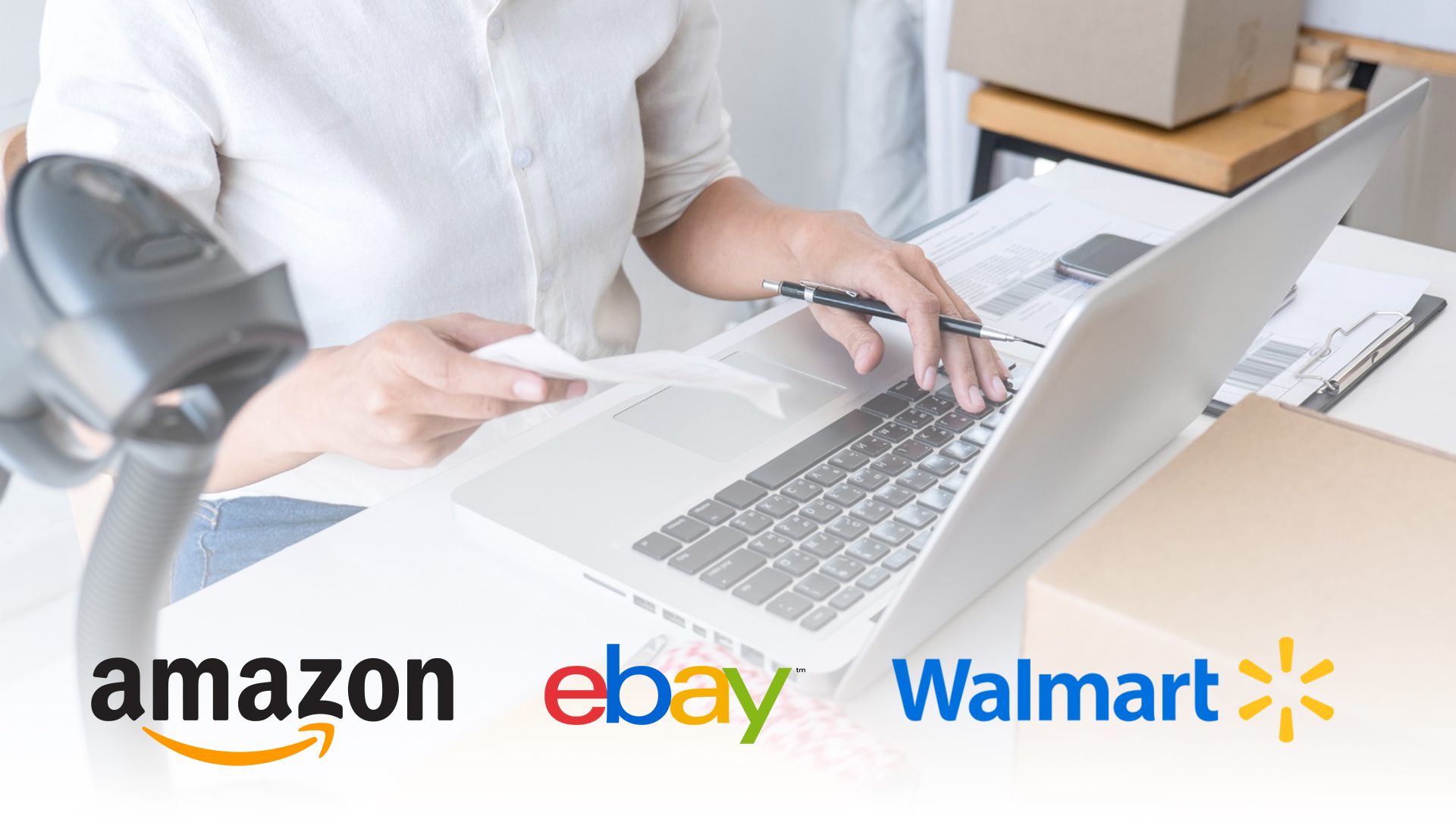Blog

Family-owned businesses and small retailers can view online marketplaces as a direct threat to the brick-and-mortar way of (retail) life.
Online shopping has grown since it took hold in the early 2000’s as a way to find products that might not otherwise be available locally. It filled the needs of people who may have had any number of challenges getting to the physical store.
The idea of eCommerce also flaunts the “traditional way” of shopping. You used to head to your local retailer for groceries, goods, and necessities. This approach supports local businesses and keeps their dollars within the area’s economy. But as time goes on, shopping trends, like any trend, change.
Part of those retail trends now includes eCommerce. It boils down to this: If a brick-and-mortar retail business doesn’t have some form of online sales, it’s at a severe disadvantage.
We will share five facts to make the concept of entering the online marketplace realm more digestible to SMB retailers curious about eCommerce marketplaces.
- Making the shift to eCommerce Marketplaces is a Key Retail Strategy
- There is a Huge Market Share For Every Retailer to Get a Slice of The eCommerce Pie
- The eCommerce Middleman is Quite Useful and Can be Your Business Friend
- Your eCommerce Products Are in Front of a Worldwide Audience 24/7
- Integrations for Your Point of Sale Means You Can Manage Marketplace Orders
We’re not here to give you sticker shock, but did you know the global eCommerce market is worth 18.8 trillion dollars? It’s projected to grow to over $45 trillion by 2034.
Why does this matter?
That trillion-dollar pie is open to anyone willing to put in the work!
Making the shift to eCommerce Marketplaces is a Key Retail Strategy
Since 2017, the online retail landscape has undergone a seismic shift, with Amazon continuing to dominate e-commerce.
As of 2024, Amazon’s market capitalization has skyrocketed to over $6.3 trillion, a staggering increase from its 2017 valuation of $150 billion. This growth reflects the accelerating trend towards online shopping, further catalyzed by global events like the COVID-19 pandemic. That same broad marketplace value is forecasted to grow to $47.8 trillion by the end of 2030.
eCommerce sales in the United States, establishing a position as the go-to platform for online shoppers. This dominance means that approximately one out of every 15 purchases in the U.S. occurs through Amazon or other major online marketplaces.
There is a Huge Market Share For Every Retailer to Get a Slice of The eCommerce Pie
The eCommerce ecosystem is one of constant growth and diversification. Platforms like Walmart Marketplace, Etsy, and Shopify have emerged as significant players, offering alternatives for both consumers and sellers.
For many small businesses, mainly mom-and-pop shops, the need to design and maintain a standalone eCommerce website has remained the same. By tapping into established marketplaces, these merchants can easily venture into omnichannel retail without the burden of significant upfront investment or technical expertise. Small stores can effectively operate 24/7, selling products in real-time globally.
This diversification gives small businesses more options to reach their target audiences. It reduces the risk of over-reliance on a single platform. Initially perceived as a threat, these tech giants now offer unprecedented opportunities for small businesses:
| Opportunities | Benefit |
|---|---|
| Expanded Reach | Online marketplaces provide access to a vast, global customer base. |
| Reduced Marketing Burden | Platforms handle much of the marketing and brand visibility efforts. |
| Lowered Overhead Costs | Small businesses can leverage established marketplace infrastructure. |
| Data-Driven Insights | Sophisticated analytics tools help understand customer behavior. |
| Omnichannel Presence | Businesses can maintain a presence across multiple shopping channels. |
The eCommerce Middleman is Quite Useful and Can be Your Business Friend
One of the primary concerns for small retailers regarding online marketplaces was the introduction of a “middleman.” However, platforms like Amazon have transformed this intermediary role into a significant advantage.
Amazon leverages three fulfillment methods:
Fulfilled By Merchant:
When a product is ‘Fulfilled by Merchant’ (FBM) on an online marketplace, the seller handles storage, packing, shipping, customer service, and returns. They don’t use the marketplace’s fulfillment services, giving them complete control over the process but also requiring more responsibility.
Fulfilled By Amazon:
Retailers can use ‘Fulfillment by Amazon’ (FBA), when Amazon stores, packs, ships products, and handles customer service. This process saves retailers time and effort, especially those with limited resources. However, FBA gives Amazon control over pricing, marketing, and product display, so retailers must prepare to relinquish some control over their brand.
Amazon Today:
Amazon Today allows retailers to offer same-day in-store pickup and delivery via the Amazon marketplace. This option helps local retailers attract customers seeking fast, same-day delivery, with orders delivered in the retailer’s branded bags. To use Amazon Today, retailers must integrate their POS software with Amazon, ensuring product availability is visible to shoppers. Once the customer selects same-day pickup or delivery, an Amazon driver picks up the order and delivers it to the customer’s doorstep.
For retailers already operating their eCommerce sites, selling additional products on multiple marketplaces can help them significantly expand their customer reach. This system of fulfillment and different options gives retailers of any size options that work best for them.
Learn more about To Sell On Amazon Or Not To Sell On Amazon
Your eCommerce Products Are in Front of a Worldwide Audience 24/7
The 21st-century consumer’s love for instant gratification has been critical to eCommerce growth.
Consumers expect fast delivery and seamless shopping experiences across all devices and platforms. The ability to shop anytime, anywhere, for virtually anything has become the norm, putting pressure on small businesses to adapt or risk obsolescence.
While brick-and-mortar stores remain essential to the retail landscape, eCommerce and online marketplaces are increasingly outpacing physical stores in terms of growth and consumer preference. The benefits of online or omnichannel marketplaces include cost savings, time efficiency, and increased reach.
Read More: 5 Facts About Online eCommerce for Retailers
Integrations for Your Point of Sale Means You Can Manage Marketplace Orders
integration capabilities of retail point of sale (POS) software and eCommerce platforms have reached new heights, offering seamless connections with major online marketplaces such as Amazon, Walmart, eBay, and emerging platforms like Etsy and Shopify.
These integrations have become a game-changer for merchants seeking to navigate the complex landscape of omnichannel retail.
Key Benefits of POS Marketplace Integrations:
| Integrated Function | Benefit |
|---|---|
| Centralized Management | Merchants can now effortlessly manage products, inventory, and sales across multiple channels from a single, unified platform. This centralization eliminates the need to juggle multiple systems, reducing complexity and the potential for errors. |
| Real-Time Inventory Synchronization | One of the most critical features of these integrations is real-time inventory updates across all connected marketplaces. This ensures that stock levels are accurately reflected on every platform, preventing overselling and the associated customer disappointment. |
| Streamlined Order Processing | Orders from various marketplaces can be processed, fulfilled, and tracked within the POS system. This streamlined approach significantly reduces the time spent on order management and improves overall operational efficiency. |
| Consolidated Reporting | Integrated systems offer comprehensive reporting tools that aggregate data from all sales channels. This provides merchants with valuable insights into overall performance, best-selling products, and channel-specific trends. |
| Automated Pricing and Promotion Management | Many integrations allow for centralized control of pricing and promotions across all marketplaces. This feature enables merchants to maintain consistent pricing strategies or tailor offers to specific platforms with ease. |
| Enhanced Customer Service | With all order information centralized, customer service representatives can quickly access order details, regardless of the originating marketplace. This leads to faster resolution of customer inquiries and improved satisfaction. |
The time and effort saved through these integrations are crucial for businesses looking to scale and expand. By automating repetitive tasks and consolidating data, merchants can focus on strategic decisions and growth initiatives rather than getting bogged down in day-to-day operational details.
Utilizing integrations from retail POS software not only saves time but also significantly reduces errors in the product sales pipeline. The elimination of manual data entry across multiple platforms minimizes the risk of human error, ensuring greater accuracy in inventory counts, order details, and financial records.
Looking Ahead and Adapting to Changing Marketplace Trends
For smaller retailers, embracing online marketplaces is no longer just an option; it’s increasingly becoming necessary for survival and growth in the digital age.
Success in these marketplaces requires strategy, including understanding platform dynamics, optimizing product listings, effectively managing customer reviews, and diversifying across multiple marketplaces to mitigate risks.
Retailers can prepare for the future of eCommerce and Marketplaces with a few simple insights:
| Trend | How to Adapt |
|---|---|
| AI and Personalization | Advanced AI algorithms will offer even more personalized shopping experiences. |
| Sustainability Focus | Online marketplaces are prioritizing eco-friendly products and practices. |
| Augmented Reality (AR) Integration | AR technologies are becoming more prevalent in online shopping. |
| Social Commerce Growth | The integration of eCommerce with social media platforms is accelerating. |
| Localization within Globalization | There's a growing emphasis on supporting local businesses within global marketplaces. |
While physical retail stores will always have a place in the market, small retailers must adapt to the digital shift to ensure long-term success. The key lies in leveraging the power of online marketplaces, integrating efficient systems, and embracing the omnichannel approach that modern consumers expect.
As we look towards the future, the retailers who thrive will successfully blend the convenience of online marketplaces with the personal touch that small businesses are known for.








